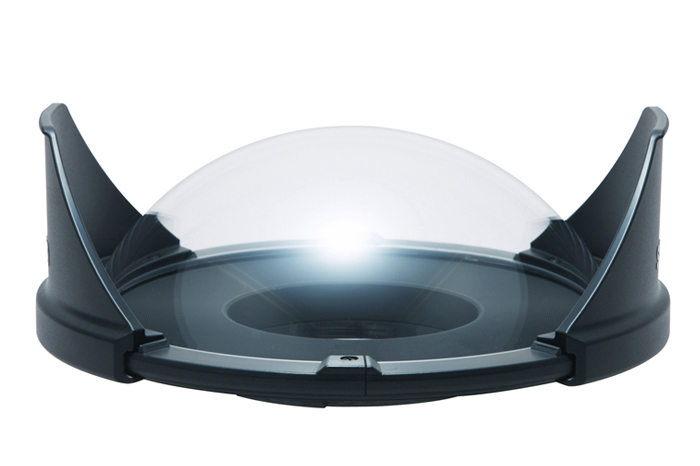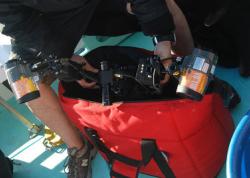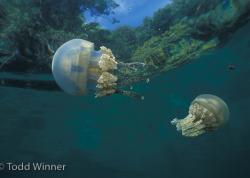Dome Ports and Macro Ports
If you purchase your dSLR UW housing without a port, you’ll find that it will have a large hole in it. Don’t take it underwater! Yes, this is where the port goes. You’ll have to purchase 1 or more ports.
Dome ports, also known as Wide-Angle ports
Wide-angle lenses, less than 35mm, should be placed behind a dome port.
Advantages of Dome ports over flat ports for wider lenses
The image is not magnified due to the refraction of water, which means you retain the "wideness" of the lens
Color and sharpness is better with a wide angle lens, since you can get closer to your subject due to advantage #1
There is less chromatic aberration (color fringing)
Dome port materials - glass and acrylic
Most dome ports are made of acrylic, although more expensive ports are made of glass. Glass ports can give sharper images than acrylic ports, and are more resistant to scratches, but scratches are permanent. Glass ports are also heavier. Scratches in acrylic ports can be removed with a mesh kit. You can read about my sea & sea glass and acrylic dome port review.
Zoom lens less than 35mm at their widest point should be behind dome ports.
Make sure you get a neoprene cover for your dome port.
Dome port size
Fisheye lenses will do well in any size dome port. Rectiinear lenses need larger dome ports. The wider the lens, the wider the dome port should be. That said, most people use a standard 8 or 9 inch dome port for their various wide-angle rectilinear and fisheye lenses.
Please see the dome port optics section for more details on dome ports, and how dome ports cause the camera to focus on a "virtual image" in front of the dome.
Shooting macro behind a dome port
Macro can be shot behind a dome port, but you must be very careful not to scratch your port when approaching a subject. Image quality will actually be better than behind a flat port, because of less chromatic aberration, and because you must get closer for the same shot, resulting in less water between you and the subject. Magnification will be 30% less when using a dome port, which can actually be useful when shoot medium-sized fish or larger macro subjects. Sometimes I shoot my Nikon 60mm macro lens from behind my compact dome port.
Flat ports, also known as Macro ports
Macro lenses, greater than 35mm, should be placed behind a flat port. Flat ports will magnify the image more than a dome port, allowing a lens to reach its true magnification potential. A flat port will magnify an image approximately 25%. They can also introduce a small amount of chromatic aberration at the edges of the photo, more noticeable in wider lenses. This can be corrected in photoshop.
You shouldn't use your macro lens in a dome port - you will most likely bang the dome port against a subject. The subject won't be magnified as much as it will be in a flat port. However, people have done it without adverse effects, especially when taking a 60mm lens out to shoot fish.
If you try to use your wide-angle port in a macro port, the photo may vignette. Wider focal lengths can also suffer from chromatic abberation. It's best to use them in a dome port.
Port extensions
Instead of purchasing 2 different ports for 2 different lenses (e.g. - 60mm and 105mm), people will sometimes buy a port and a port extension, which extends the port for the longer lens. Most WA lenses will also require an extension with the dome port, not only so the lens will fit inside the port, but also because WA lenses must have proper placement inside a dome for optimal sharpness. Many beginners make the mistake of using a lens behind a dome port without the proper extension and/or diopter, and wonder why the images don't appear sharp.
Small Prime fisheye lenses like the Nikon 10.5mm and 16mm, and sigma 15mm generally don’t need extensions. The tokina 10-17mm needs a 15-20mm extension, and most other wide-angle lenses need a 40-60mm extension. Check with your housing manufacturer.
Zoom gears
Any zoom lens will need a custom zoom gear, created by your housing manufacturer, which will allow you to zoom your lens underwater. The price of these can vary from $40 to $180, so do your research.
Focus gears
Some photographers prefer to manually focus a macro lens when doing 1:1 or greater macro photography. A custom focus gear will have to be purchased for each lens. Other people prefer to use the "lock and rock" method (lock focus, and rock back and forth), change focus points, or use continuous focus, and hit the shutter release when the desired focus has been achieved.
Many people I know don’t have a need for focus gear. I certainly don’t with my Nikon 60mm and 105mm VR, but some people like them for macro work.
Further Reading

RECOMMENDED ARTICLES
SUPPORT THE UNDERWATER PHOTOGRAPHY GUIDE:
The Best Service & Prices on u/w Photo Gear
 Visit Bluewater Photo & Video for all your underwater photography and video gear. Click, or call the team at (310) 633-5052 for expert advice!
Visit Bluewater Photo & Video for all your underwater photography and video gear. Click, or call the team at (310) 633-5052 for expert advice!
The Best Pricing, Service & Expert Advice to Book your Dive Trips
 Bluewater Travel is your full-service scuba travel agency. Let our expert advisers plan and book your next dive vacation. Run by divers, for divers.
Bluewater Travel is your full-service scuba travel agency. Let our expert advisers plan and book your next dive vacation. Run by divers, for divers.





























